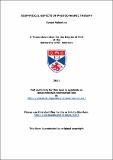Files in this item
Biophysical aspects of photodynamic therapy
Item metadata
| dc.contributor.advisor | Wood, Kenny | |
| dc.contributor.advisor | Moseley, Harry | |
| dc.contributor.advisor | Brown, C. Tom A. | |
| dc.contributor.author | Valentine, Ronan | |
| dc.coverage.spatial | 202 | en_US |
| dc.date.accessioned | 2012-03-27T16:08:42Z | |
| dc.date.available | 2012-03-27T16:08:42Z | |
| dc.date.issued | 2011-11-30 | |
| dc.identifier.uri | https://hdl.handle.net/10023/2471 | |
| dc.description.abstract | Photodynamic therapy (PDT) is a multimodality cancer treatment available for the palliation or eradication of systemic and cutaneous malignancies. In this thesis, the application of PDT is for the treatment of non-melanoma skin cancer (NMSC). While PDT has a well-documented track record, there are, at this time no significant indicators to suggest the superiority of one treatment regime over the next. The motivation for this work is to provide additional evidence pertaining to PDT treatment variables, and to assist in optimising PDT treatment regimes. One such variable is the treatment light dose. Determining the light dose more accurately would assist in optimising treatment schedules. Furthermore, choice of photosensitiser pro-drug type and application times still lack an evidence base. To address issues concerning treatment parameters, fluorescence spectroscopy – a valuable optical diagnostic technique – was used. Monitoring the in vivo PpIX fluorescence and photobleaching during PDT was employed to provide information pertaining to the progression of treatment. This was demonstrated by performing a clinical study at the Photobiology Unit, Ninewells Hospital and Medical School, Dundee. Two different photosensitiser pro-drugs – either 5-aminolaevulinic acid (ALA) or its methyl ester (MAL) – were investigated and based on the fluorescence and pain data recorded both may be equally suitable for topical PDT. During PDT, surface fluorescence is observed to diminish with time – due to photobleaching – although cancerous cells may continue to be destroyed deep down in the tissue. Therefore, it is difficult to ascertain what is happening at depth in the tumour. This raised the questions; How long after surface PpIX fluorescence has diminished is the PDT treatment still effective and to what depths below the surface is effective treatment provided? In order to address these important questions, a three-dimensional (3D) Monte Carlo radiation transfer (MCRT) model was used to compute the light dose and the ¹O₂ production within a tumour, and the PpIX fluorescence emission from the tumour. An implicit dosimetry approach based on a single parameter – fluorescence photobleaching – was used in order to determine the ¹O₂ generation, which is assumed to be related to tissue damage. Findings from our model recommended administering a larger treatment light dose, advocating an increase in the treatment time after surface PpIX fluorescence has diminished. This increase may ultimately assist in optimising PDT treatment regimes, particularly at depth within tumours. | en_US |
| dc.language.iso | en | en_US |
| dc.publisher | University of St Andrews | |
| dc.subject | Photodynamic therapy | en_US |
| dc.subject | Non-melanoma skin cancer | en_US |
| dc.subject | Protoporphyrin IX | en_US |
| dc.subject | Fluorescence | en_US |
| dc.subject | Photobleaching | en_US |
| dc.subject | Monte Carlo radiation transfer modelling | en_US |
| dc.subject | Light dose | en_US |
| dc.subject | Singlet oxygen | en_US |
| dc.subject.lcc | RC271.P43V2 | |
| dc.subject.lcsh | Photochemotherapy | en_US |
| dc.subject.lcsh | Skin--Cancer--Photochemotherapy | en_US |
| dc.subject.lcsh | Fluorescence spectroscopy | en_US |
| dc.subject.lcsh | Biophysics | en_US |
| dc.title | Biophysical aspects of photodynamic therapy | en_US |
| dc.type | Thesis | en_US |
| dc.type.qualificationlevel | Doctoral | en_US |
| dc.type.qualificationname | PhD Doctor of Philosophy | en_US |
| dc.publisher.institution | The University of St Andrews | en_US |
| dc.publisher.department | Ninewells Hospital and Medical School | en_US |
This item appears in the following Collection(s)
Items in the St Andrews Research Repository are protected by copyright, with all rights reserved, unless otherwise indicated.

